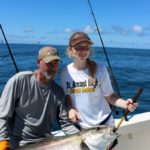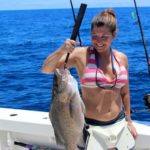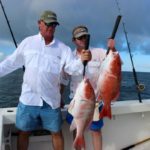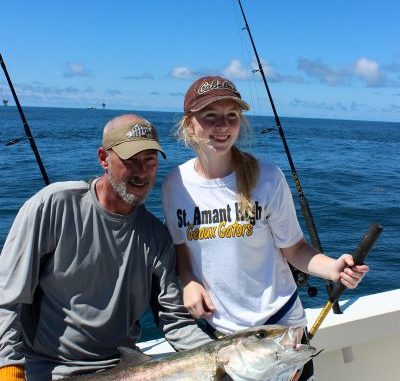
What tackle should you pack when you head to the rigs off Grand Isle, Fourchon or Cocodrie? These veteran charter captains help narrow down the options.
Offshore fishing to the west of Venice is a different game altogether. Variety is the name of the game in Southeast Louisiana ports such as Grand Isle, Port Fourchon and Cocodrie, where runs to the storied yellowfin tuna grounds are seen as untenably long.
Red and mangrove snapper, cobia, amberjack and dolphin dominate fishboxes in those waters. Each requires specialized tactics, but they are captured mainly by anglers in relatively small boats.
So what’s the best strategy for these runs?
Storage can be an issue even on the most-thoughtful design, so anglers must be nimble and efficient in what rods and reels are brought along — while still being prepared to go from battling fish favoring the short game (making a mad dash to get to the rigs) or the long game (faster, open water tactics for escape).
Tommy Pellegrin of Custom Charters out of Cocodrie and Darryl Carpenter of Reel Screamer Guide Service out of Grand Isle know from many years of experience that you can’t take every rod in the shed.
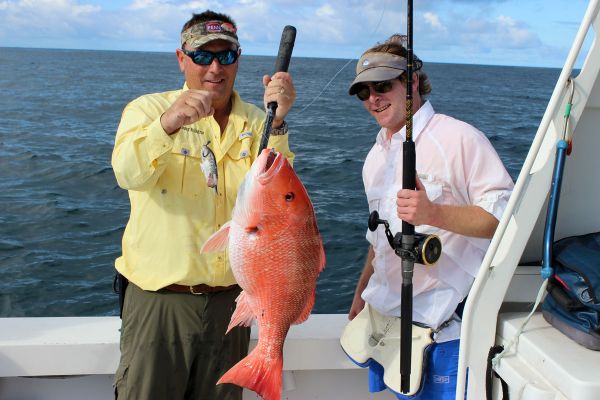 At the same time they need to be ready for most any fish in the Gulf. Their strategies for rod readiness allow them to be relatively tidy without sacrificing utility with six often untested anglers aboard.
At the same time they need to be ready for most any fish in the Gulf. Their strategies for rod readiness allow them to be relatively tidy without sacrificing utility with six often untested anglers aboard.
“The basic formula I use is that the rods and reels and lines are mostly the same,” said Carpenter, who like Pellegrin mixes in a fair amount of knuckle-busting rig action with snapper and amberjack among others and open water races with dolphin and tuna. “It’s what’s at the end of the line that’s different.”
But even with reels being built tough and able to hold many yards of unforgiving braided lines, things do happen that can put outfits on the shelf. So mixing in rod-and-reel combos that can be more utility players than specialists is crucial.
Both captains agree that, with today’s advances in braided line and reel technology, the spinning reel takes center stage in a game where versatility is key.
“Almost everything with snapper these days is up close and personal,” Pellegrin said. “Whether it’s chumming up the mangroves or picking out the red snapper on the surface that we want to keep, they can all be caught on the same setup.
“At the same time, in doing this, we’re not just lowering a bait down 60 to 100 feet as much. Customers are tossing the bait to the fish they’re seeing. That’s got to be done with a spinning reel, not a reel that can be backlashed.”
Then it’s a matter of rigging everything up correctly.
“If I had to just narrow it down to, say, two rods person, I would load the boat with a dozen spinning rods and reels with 65-pound Pro Spec braid and fill it to the top,” Pellegrin said. “I’d tie the Mustad Ultra Point hook (model 39942 in 4/0 or 5/0) onto a fluorocarbon leader with a uni to uni knot.”
The Penn lineup of saltwater spinning reels have aesthetics that match up with their workman-like use. No shiny silver plating — almost a blood-and-guts look belying their strength and durability.
Carpenter and Pellegrin have their preferences, but they agreed that all Penns pass the harshest tests of salt, fish, line demands and customers.
“You can get away with almost any fish that we come across in the Gulf with a 6000- to 8000-class spinning reel and a rod with some backbone,” Pellegrin said. “I like both the Penn Battle and the Penn Conflict.
“And I’d go with six 8000s, and six mixed 6000- and 7000-class reels. I might mix in a few 5000s, but really they’re only good for mangroves.”
Pellegrin didn’t mince words when explaining his philosophy of keeping things basic in a Gulf full of sea creatures of all sizes, speeds and temperaments.
“The old saying about real estate is ‘location, location, location.’ It’s the same with fishing equipment: quality, quality, quality,” he said. “You’ll do so much better in the long run by investing in quality rods, reel and line.”
Pellegrin said just about the only thing they change up in the way of spinning outfit use is the drag. Mangrove snapper 10 pounds and up require a quick and substantial lean by the angler to get them out of the unforgiving steel and barnacle encrusted lair. It also takes a drag setting that most think would break the rod.
For open-water fish like dophin and tuna, drags are backed way off.
“All we do is adjust the drag,” Pellegrin explained. “Tuna need to run, dolphin need to run. The mangroves — you’ve got to horse them in.”
Pellegrin said he uses a uni knot to splice braided main lines to leaders to protect his rods’ eyes from overzealous customers.
“Customers who aren’t used to an offshore setup are going to want to reel the hook all the way to the tip of the reel, no matter how many times you tell them,” he said. “They get excited, and everything you tell them can go in one ear and out the other. If you have a swivel connecting braid to the leader, they’re going to reel it all the way up to the rod tip, and that swivel is going to pop out the tip insert. That’s going to basically put that rod out of business for the day.
“With the uni to uni knot — I can tie it pretty fast when you lose a leader to a big mangrove — my guys can reel it all the way to the hook with no problem.”
And the same spinning outfits used to deftly pitch a cut bait in between steel for mangroves can handle big amberjacks — perhaps the hardest-pulling fish in the Gulf — when they decide to crash the party.
“I like to fish mangroves in clear water out in deep water early in the season, and that’s the time when the big amberjacks will come up and try to eat everything,” Pellegrin said. “Later on in the summer they leave us alone a little more and don’t come up as much.”
Regardless of when it happens, however, spinning outfits have to withstand the punishment of an angry AJ hooked in close quarters.
Efficiency notwithstanding, both captains agreed that a couple of slots in the rod lineup have to be reserved for brawling with the occasional billfish and large yellowfin that might make show up.
“Unless I’m absolutely sure that we’re only going for mangroves close in, I’m always going to have a two ‘Golds,’ the bigger conventional reels used in bluewater fishing,” Carpenter said. “I’ve had too many times when we’re chumming for mangroves and a yellowfin cruises through the chum.
“I don’t care what I’m doing — unless I’m trout fishing I’ve got two of (the beefed up rigs) on the boat.”
Carpenter turns to other models of Penns.
“As far as mangroves go, I use exclusively the Penn Battle or Penn Fierce (spinning reels) in the 4000 range,” said Carpenter, adding that they’re matched up with Shakespeare Ugly Stik Tiger rods.
High marks are given to the Tigers for toughness.
Versatility is the name of the game for these products and Carpenter said the Battles and the Fierces are wonderfully adept as snapper snatchers in close quarters, offering big drag to winch fish from barnacle-laden cross beams and rig legs as well as a trolling setup for smaller grass-line dwellers.
“The beautiful thing about them is you can lighten up on the drag to catch hardtails, (and) you can pull smaller baits on the rip for chick dolphin,” Carpenter said. “You can have a couple of small baits out there with your (Penn) 30s and 50s, and not limit yourself to only the fish that are going to bite the big baits.”
“As far as the (red) snapper rigs go, I use the Penn Fathoms and Squalls (conventional) on the matching rods (Rampage). They’re a little bit light for amberjack unless you’re using a jig. If you’re working a jig, they do great but you’d better be ready to pull (the fish) out.
“My normal configuration when I leave in the morning, I’m leaving with four Penn 50s, most on the bent butt (rods). I’m taking four to six spinning reels — the Penn Fierce matched up with the Tiger rods.”
Carpenter rounds out his arsenal with a quartet of Penn Squall conventional reels matched up with Rampage rods in the 20- to 50-pound class for more-conventional bottom fishing for red snapper, grouper and amberjack.
“All of these reels I’ve mentioned are full of 80- to 130-pound (Spiderwird Invisibraid),” he said. “That may sound like overkill, but the reels can handle it
“And this is what allows us to carry as few outfits as we do.”
